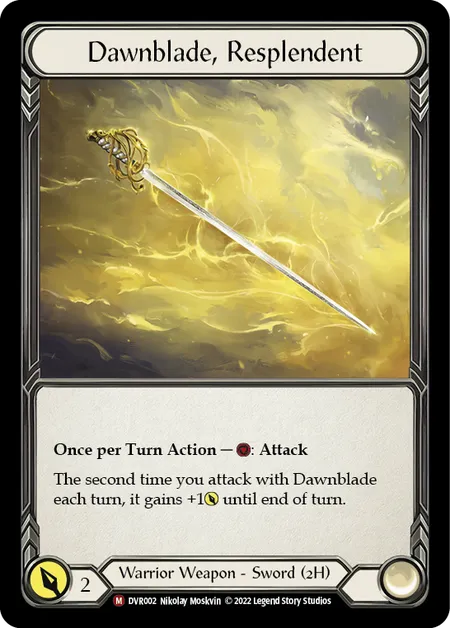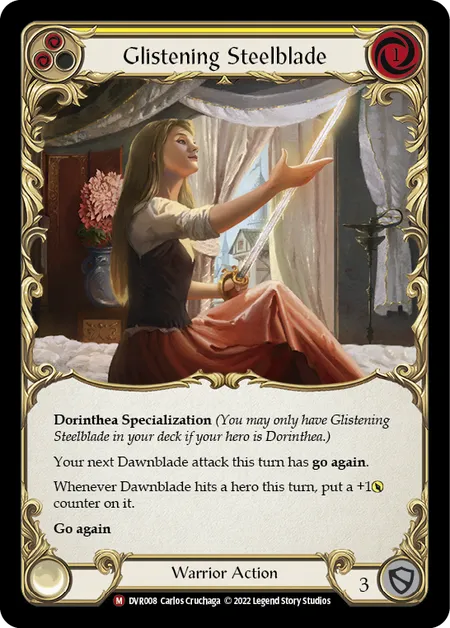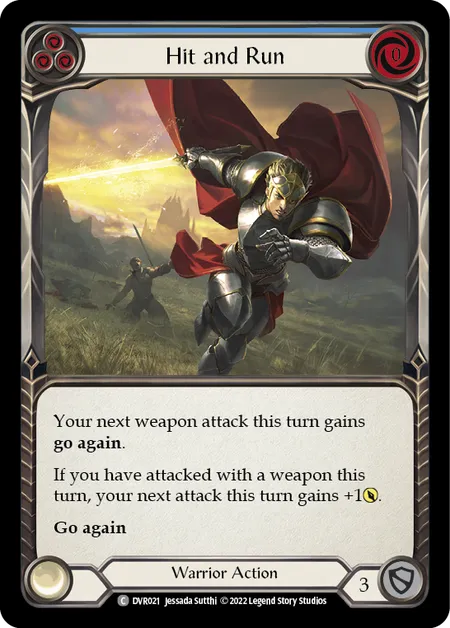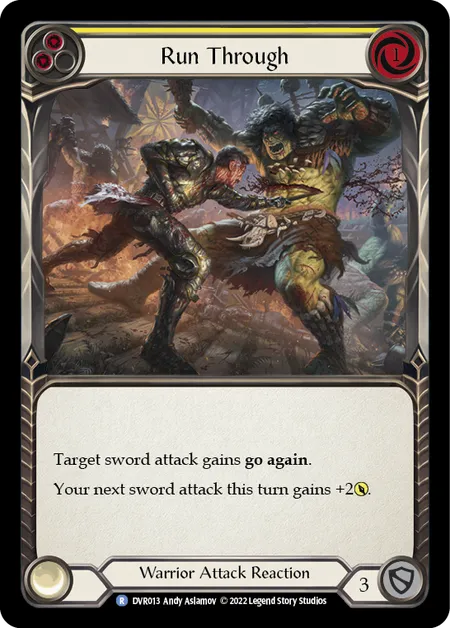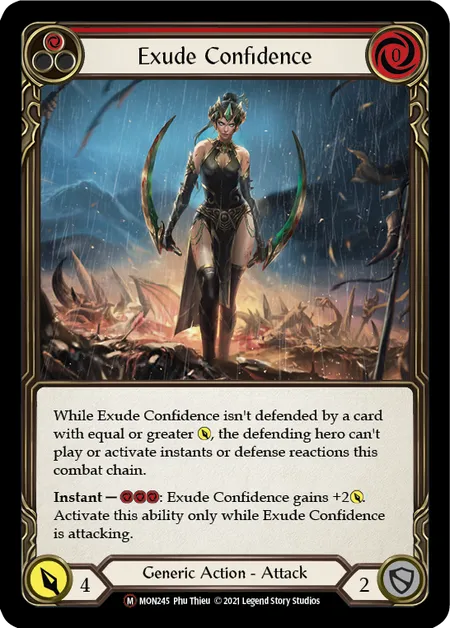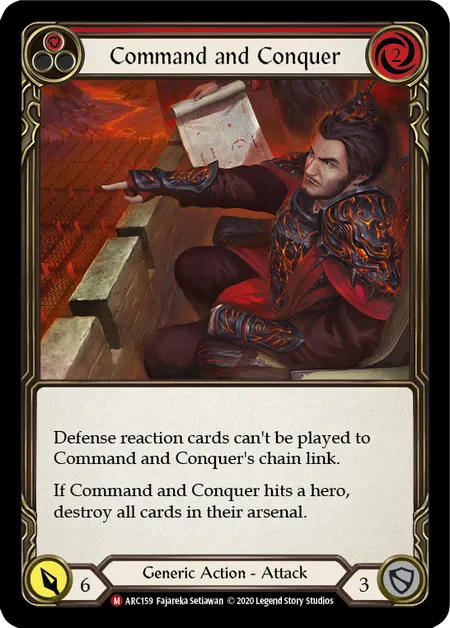Competitive player, strategy writer, tournament organizer, longtime TCG enthusiast, and finalist at the Calling Auckland 2021, Kiki Labad has long been a staple in the New Zealand FAB community. We're pleased to welcome them as our first guest writer for the Skirmish season, reintroducing you to Dorinthea, Quicksilver Prodigy!
A little-known fact about me is that Dorinthea is the reason I got into Flesh and Blood. She’s strong, intelligent, and adept in combat. I quickly grew to love the game with the Dawnblade in my sheath. It’s safe to say I was excited when I saw that the recently released Classic Battles would feature a brand new Dorinthea.
Dorinthea, Quicksilver Prodigy is one of the most exciting new heroes to be added to the Blitz pool of heroes, just in time for the upcoming Skirmish season! A twist on a classic tale, she provides a similar style of gameplay to the original Dorinthea Ironsong, but with the abilities in reverse, she gives you a level of consistency that Thea 1.0 does not provide. Let’s delve together to see how we can build her up from the Classic Battles list to prepare your journey to your Skirmish events!
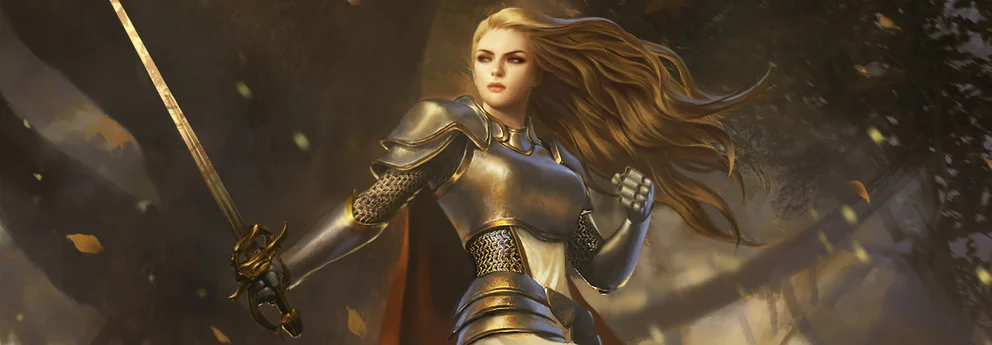
Why Should We Play the Quicksilver Prodigy?
The most notable difference with Dorinthea, Quicksilver Prodigy, is that she heavily incentivizes you to play with the all-new Dawnblade, Resplendent. The combination of the two allows you to attack multiple times with your weapon, simply by giving it go again; removing the hoop of having to hit that Dorinthea Ironsong had to jump through. While Ironsong had a functional on-hit that encouraged blocking from your opponent, the consistency to allow your sword to swing a second time means you’ll often be able to get some damage through each turn.
New Tools!
When the spoiler season for the Classic Battles came out, Glistening Steelblade caught the attention of everyone. Not only was it a non-conditional go again, it also provided a powerful on hit that put +1 counters onto your weapon. Unlike the original Dawnblade, Dawnblade Resplendent does not have a clause to retain the counters, which makes it the perfect tool here to combine with Glistening Steelblade. Leaving your opponent in the dark about whether they should attempt to block out the first or second swing here will mean you can often get that coveted counter, increasing your weapon to 3 and 4 instead of 2 and 3.
Building the Deck
Conveniently, the Dorinthea, Quicksilver Prodigy deck gives us a good idea of what we want to be doing. There is a large portion of the deck that is dedicated to go again, which is key for the functionality of the core strategy. The remainders of the deck are ways to give the weapon more power. With this in mind, we can start to look for cards that do these things in a way that improves power level and consistency.
Go Again!
The first thing we are looking at are Go Again enablers. Our goal is to attack with the sword twice every turn. The preconstructed build provides us with 15 sources of go again. This feels like a good place roughly to start with Go Again, considering we usually want one of these per turn. In order to make the most of this and still apply pressure, we generally want 0 cost Go Again enablers. This allows us to function well using a blue resource card in order to attack twice as well as leaving a resource free to use on potential sword buffs. Cards like Hit and Run are perfect for this as they also can be used to increase the damage of your second swing should you come across multiple go again sources in a hand.
The other thing we are looking for when considering Go Again sources are cards that also provide additional value. The previously mentioned Glistening Steelblade is a great example of a card that gives go again as well as incentivizing your opponent to ensure your sword does not hit. Another card provided to you from the preconstructed build is Run Through. This is an excellent card that gives an unconditional Go Again to the sword as well as buffing the second attack. Despite the fact that these two examples do cost a resource to play, both of these provide enough additional pressure to the opponent to be worth the resource spent to play them. This will however demand that we play blue cards specifically for resources in order for us to make our plays.
The assumption of the deck is that it will swing twice every turn. As a result, using Non-Attack Actions such as Spoils of War to gain your go again shouldn’t result in giving your opponent too much information about how your turn is going to play out. Regardless, that’s not to say that the Reaction Go Again effects can’t be effective. Having cards like Glint the Quicksilver and Run Through in your deck means your opponent has to consider that you may attack twice in a turn. They may still not block so much on the first attack, allowing you to use your damage increasing Reactions on the first sword attack.
Reprise!
Reprise was the key mechanic of Dorinthea Ironsong, giving your cards bonuses whenever your opponent would block with cards from their hand. While these bonuses are powerful, Dawnblade Resplendent not having on-hit effects makes it less likely that your opponent is going to block from their hand.
So the first question here is what kind of Reprise cards are we looking to play, if any at all? Thankfully with the introduction of Crucible of War and later Everfest, we now have more Reprise cards that still have some functionality without the Reprise. A card like red Out for Blood still gives us +3 damage to get over something like 2 equipment blocks on our first sword, which is critical in getting the few on hits we do have like Glistening Steelblade. Secondly we are looking at cards with Reprise that are too powerful not to play with. Singing Steelblade and Glint the Quicksilver are both powerful Reprise cards that have been a staple of Dorinthea Ironsong’s core of cards since the beginning.
Finally, blue Reprise cards have value in this deck. Blue cards usually end up on the bottom of your deck, as they’re pitched to make your plays early in the game. Having resource cards in the end that add some value to your attack, like blue Overpower becomes important as at the end of the game, when the life totals are lower, your opponent is more incentivised to block both sword attacks.
The Importance of Resource Cards in this Deck
The upside of a deck like Dorinthea, Quicksilver Prodigy is that she’s aiming to do the majority of her damage through her weapon, meaning that you will not need to use as many cards from your hand during your offensive turns. That combined with a large majority of Warrior cards blocking for 3 means that she excels in a grindy midrange strategy. However, relying on the weapon means that she also has a reliance on blue cards to pay for the two weapon swings as well as potential weapon buffs you may need to play during the turn.
Conveniently also, a lot of the cards in the deck cost 0, which means that you can get away with having turns that only require a yellow to perform a reasonable turn. Thankfully with the new Classic Battle decks, Dorinthea now has access to multiple powerful yellow cards such as Run Through and Glistening Steelblade.
With these in mind, we can consider what kind of roles the different resource values in our deck have.
- The red cards are the power cards. We are ideally not using these to pitch, but to instead apply damage and pressure to the opponent.
- The yellows are sometimes resource cards, so these need to be powerful enough still to justify the fact that we aren’t using blue resource cards in their place. We are mostly going to be looking at niche effects that don’t appear in the other colours like Twinning Blade and the aforementioned yellows.
- We want the blues to have late game value as we’re going to be pitching them mainly for the end of the game. Reprise effects are fairly effective in this respect but we can also be looking for other late game cards such as Steelblade Shunt or cards that we would also play in other colours, but the power decrease of the card doesn’t affect its purpose in the deck. An example of this would be something like Hit and Run, where we are playing it for the 0 cost Go Again portion of the card, and the remainder of the effect is a bonus.
Keep in mind that the plays above are the kinds of turns we have when we are treading water, but what are the plays we are aiming to make when we set up for a big turn? Considering our big turns involve playing multiple cards like Steelblade Supremacy and Glistening Steelblade in addition to the reaction pumps to get the on hit effects, we’re going to need more than 3 resources for these turns. We do not want to have to pitch two cards to make these sorts of plays as that hinders the amount of cards we have to work with. Thankfully we have access to two cards here that can provide us with resources for these big set up turns!
Firstly, we have Energy Potion. This is a powerful card from the original set of Flesh and Blood and has frequently had a place in Thea’s deck builds. A card that can be used to pitch for a turn, it also has the upside of being able to be played to provide 2 resources for our big turns. In the late game, any Energy Potions that have remained in play can be used to pay for two weapon swings if we are able to keep a Go Again card after blocking.
The other card we have that works to provide us with a burst of resources is Courage of Bladehold. This card is very powerful in our deck, as it reduces the cost of the weapon attack to 0 for a whole turn. Functionally acting as another Energy Potion, it starts to shine if we are able to combine it with a Twinning Blade for a third attack. In addition to this, it starts in play, so it isn’t a card we have to worry about drawing and we can use it to block on the turn that we intend to use 5 cards to burst through our opponent’s hand and get the powerful on-hit effects.
Combat Without the Dawnblade?
Just because Dorinthea focuses mainly on her sword to deal her damage, that doesn’t mean that's her only option to apply pressure. Should you get multiple Go Again enablers for a turn, having some number of attack actions means that you are able to take advantage of that scenario. Let's run through some of the options you could choose to use to fill that role.
Snatch
This card is a Welcome to Rathe classic. The red version suits this style of deck perfectly, costing 0 as to not be a strain on the resources while also dealing 4 damage, which goes over the usual 3 card block from a Flesh and Blood card. The situation where we are looking at using this card is when we start the turn with a Go Again enabler as well as a Hit and Run. In this scenario, we can use the first Go Again enabler on the first sword swing, followed by a hit and run to give the second sword swing a buff as well as incidentally giving it Go Again only to finish with the Snatch. Assuming your opponent has blocked some damage from the first few hits this makes the Snatch finisher very strong as it is likely to replace itself to allow you to finish with an Arsenal.
Exude Confidence
Another 0 Cost 4 damage attack, Exude Confidence plays similar to another sword swing, being able to bluff power increases through the activated ability on itself. It is also a strong card against Defence Reactions, with the static ability to shut down your opponent’s Reactions and Instants. You may consider using an Equipment slot on Snapdragon Scalers which will allow you to make your sword turns non-Reactable as long as you play the sword buff actions before the Exude as to not break the combat chain once you start attacking. It’s also a target for Razor Reflex, which is another way to give it Go Again, once again playing into the idea of Exude being like another sword swing.
Nourishing Emptiness
This card is quite different from the previous two as you won’t be intending to add this card as a third attack in a Combat Chain in the same way the others can be because of the two resource cost of this card. How this card shines in a Dorinthea deck is through the fact that it will be the only Attack Action in the deck. This makes it much more possible to hit with the Nourishing in order to get the powerful hit effect. You’ll ideally want to save this for when your opponent won’t be able to use equipment to stop this from hitting. In addition, Hit and Run works particularly well with this card as the buff will be gained by Nourishing Emptiness if you have attacked with a weapon before. This makes the sequence of Go Again enabler, pitch a blue for Dawnblade Resplendent, Hit and Run, Nourishing Emptiness a powerful 4 card set up hand to get you ready for the next turn. It also incidentally doubles as a 6 power should you come across any Illusionists as well as a way to push final points of damage through onto an opponent thanks to the Dominate it gains.
For similar reasons to this, you could also consider another Flesh and Blood staple: Command and Conquer. It has a similar play pattern as the 2-Cost Nourishing Emptiness, also combo-ing well with Hit and Run. You could consider this as an option if your local meta is filled with decks that lean on the arsenal or on Defence Reactions.
My Take on the Deck
With these things in mind, here’s what I’ve come up with for the deck!
Replacement Options
The version I have built plays with a lot of options that may not be too budget friendly, especially if you’re just starting out in the game. So here are some alternatives you could consider.
Legendaries
These are the most expensive cards in the deck but by no means are they necessary to enjoy playing with Dorinthea, Quicksilver Prodigy. Thankfully, this deck already runs Refraction Bolters which work excellently as a leg piece for this deck for most match-ups. While It doesn’t boast the same defensive power as Valiant Dynamo, it still is a card to block with and arguably the more offensive card.
Crown of Providence is a powerful defensive option that gives you versatility and helps you fix your Hand. While not as powerful, you can use a card like Hope Merchant’s Hood in order to fix your hand more aggressively for higher combo potential or use Ironrot Helm for some blocking potential.
The final Legendary piece of equipment in the deck is Braveforge Bracers. This was Dorinthea’s original Legendary, providing multiple blocks as well as some additional damage over the course of the game with spare resources. Fortunately, Monarch gave us Gallantry Gold which is an explosive piece of Equipment which could be used in combo turns or to make sure you’re hitting important numbers for forcing blocks.
Majestics
While some of the Majestics in the deck, like Steelblade Supremacy and Twinning Blade have unique effects, the other Majestics in the deck are Go Again enablers. Conveniently, the preconstructed version of the deck gives you copies of Warrior’s Valor, On a Knife Edge and Blade Flash, each of which fulfil the same primary Go Again enabling role that the other Majestics do.
The other Majestic of Note in the deck is Courage of Bladehold. I touched upon this card’s usefulness in the resources section, and it’s a very critical part of the deck for the big turns you will need to win. As the card may be a little difficult to source for a Majestic, we can make use of the Blossom of Spring equipment provided in the Classic Battles. While it does not have the same blocking potential or provide as many resources, it does enough of what you need for it to be a worthwhile replacement.
The great thing about many of these replacements is that they offer an alternative benefit over the pieces I’ve chosen for my build. This ultimately means that there’s room for more experiments and possibilities to exist within your builds and you can explore what cards work for you and your playstyle!
Moving to End Step
The process I’ve gone through to build and explore the possibilities of Dorinthea, Quicksilver Prodigy took me back to 2019, opening my first ever box of Welcome to Rathe and my Dorinthea Ironsong Preconstructed deck. Pouring over all of the cards, trying to work out the math in my head and getting excited to show my friends what I had come up with, this journey felt like discovering the game for the first time all over again. It’s only fitting that Dorinthea is the hero that’s made me feel this way again. It’s been a pleasure taking this journey to rediscover the humble Warrior class and I look forward to seeing what you’re all able to do with the latest iteration of Dorinthea.
Kiki Labad is a competitive Flesh and Blood player and author of content relating to gameplay and strategy. The opinions expressed in the above article are their own and do not necessarily reflect the views of Legend Story Studios.
